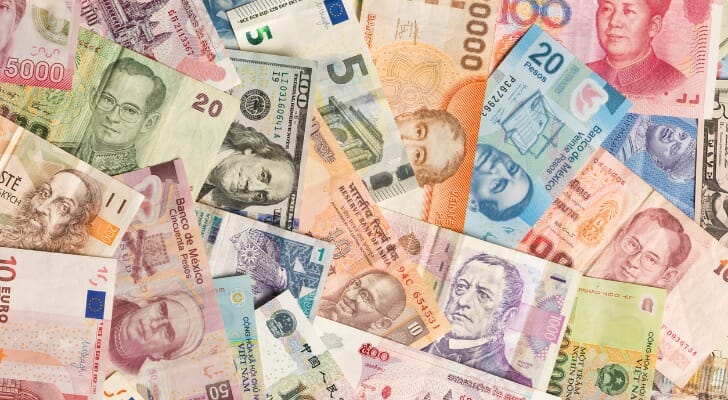
When managing your investment portfolio, there are different types of risk that need to be factored in. Currency risk, which is risk associated with fluctuations in currency values, is one of them. It’s important to understand how currency risk may affect your rate of return if you invest in foreign currencies or companies. It’s also helpful to know how to hedge against this risk in your portfolio as you pursue your investment goals. Consider working with an experienced financial advisor as you prepare to dive into into currency trading.
Currency Risk, Explained
Currency risk, also referred to as foreign-exchange risk or exchange-rate risk, is related to changes in currency values. Specifically, this risk measures the potential for gains or losses based on fluctuations in what a particular currency is worth at any given time in relation to other currencies.
If you invest in international companies or foreign currencies, then you’re exposed to currency risk. That’s important to know since it can directly affect your investment returns. If you hold investments in a foreign currency then convert them to U.S. dollars, it’s possible that you could either gain or lose, based on the latest currency exchange rates.
Currency Risk Example
Creating currency risk scenarios is simple if you understand exchange rates between different currencies. Say that you want to invest in a European company, for example. You pay 1,000 euros to buy shares. At the time you make the purchase, the currency exchange rate is 1.2 euros to 1 U.S. dollar.
Now, say you sell the stock for exactly what you paid for it in euros. All’s well, assuming the currency exchange rate from euros to dollars hasn’t changed. But if the currency exchange rate has changed and now one euro is equal to one dollar, then you’ll lose money when converting the funds from the sale; it matters little what venue you’ve chosen to make your trade.
You can apply this same formula to investments in any other currency. A simple exchange rate calculator can help you determine the value of any one currency compared to another.
Pros and Cons of Currency Risk
Currency risk is problematic because it can directly diminish the amount of gains you get to keep when you sell an investment. When exchange rates are not in your favor, then you could hand back some of your returns to cash out an investment. And unless you’re exclusively investing in U.S. securities and eschewing all foreign investment then some degree of currency risk is unavoidable. But it can also lead to investment opportunities if you’re able to capitalize on shifts in currency valuations driven by changes in interest rates.
The interest rate environment of a particular country can influence exchange rates for foreign currencies. So for example, you might consider making an investment in a foreign country that has rising interest rates underpinned by strong currency values.
Managing Currency Risk
Currency risk may be inescapable when making foreign investments but there are some things you can do to that could help to mitigate any negative impacts. Specifically, there are different hedging strategies you can use to soften the blow of currency risk on your portfolio.
First, it’s important to understand what’s happening with a particular country’s currency in relation to inflation levels and debt. If a country is carrying high levels of debt, for example, that can be a precursor to increasing inflation. As inflation rises, currency values can decline. So one of the keys to hedging against currency risk is focusing on companies that are economically stable and are set to remain so.
Next, consider how much of your portfolio you’ve allocated to foreign stocks versus foreign bonds. Bonds can be particularly sensitive to changes in currency values so you may fare better by choosing foreign bonds that have been issued in U.S. dollars versus in that country’s native currency.
Diversification can create a natural hedge for managing currency risk. By spreading some of your investment dollars across different countries and currencies, you can better manage volatility across currency prices. Just consider carefully how much of your total portfolio you want to allocate to foreign investments.
Currency-Hedged ETFs for Risk Management
Another possibility for hedging against currency risk is to use a currency-focused exchange-traded fund or ETF. Exchange-traded funds trade on an exchange like a stock. Currency-hedged ETFs employ various strategies to manage currency risk for stock and bond investments. For example, they may use futures or options as part of their investment approach.
Depending on the ETF, they may focus on developed markets, emerging markets or a mix of both. The upside of currency-hedged ETFs is that they can potentially help to reduce your exposure to losses stemming from shifts in currency valuations. Compared to an ETF that invests in foreign currencies or companies but doesn’t use hedging strategies they can be more insulated against volatility.
The downside, however, is that you might pay more to invest in them. Currency-hedged ETFs can have higher expense ratios than other types of ETFs so you may pay more to own them. And again, they don’t cancel out currency risk completely so there’s always the possibility that you could walk away with lower returns than expected or lose money.
How to Invest in Currency-Hedged ETFs
If you’re interested in purchasing shares of currency-hedged ETFs, first look for an online brokerage that offers commission-free ETF trades. This can save you money on transaction costs to buy and sell shares. Next, compare individual currency-hedged ETFs to determine which one or ones might be the best fit. For example, consider which type of markets the fund invests in and what strategies the fund uses to drive returns. Also, pay attention to the expense ratio and any other fees you’ll pay to buy or sell shares.
Then consider what hedging strategies of your own you might use to manage the investment. For example, that can include going both short and long in different foreign investments or employing options trading strategies. These approaches can make hedging against currency risk more complicated, however, so you may want to talk to your financial advisor about which moves to make.
The Bottom Line
Currency risk can pose a threat to your investment returns if you’ve allocated part of your portfolio to foreign securities or currencies. The good news is there are ways to hedge against this risk and minimize the bite it may take out of your returns.
Tips for Investing
-
Consider talking to a financial advisor about the implications of currency risk on your portfolio. If you don’t have a financial advisor yet, finding one doesn’t have to be complicated. SmartAsset’s financial advisor matching tool can help you quickly connect with professional advisors in your local area. If you’re ready, get started now.
-
One key way of keeping an eye on the value of a currency is to monitor how much inflation it is experiencing. A free, easy-to-use inflation calculator can give you a quick read on that key metric.
Photo credit: ©iStock.com/YinYang, ©iStock.com/metamorworks, ©iStock.com/Maxiphoto
The post Understanding Currency Risk and Examples appeared first on SmartAsset Blog.





